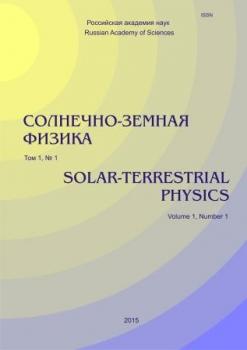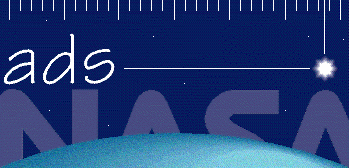Irkutsk, Russian Federation
Irkutsk, Russian Federation
Using SDO/HMI data, we have studied the dynamics of small-scale magnetic field elements in the photosphere during the formation of small active region USAF/NOAA 12761. The choice of this region is due to the fact that it formed near the central meridian at the minimum of the 11-year solar activity cycle in the absence of strong background magnetic fields. It has been established that two days before the formation of the first pores, the initially observed small-scale structure of the magnetic field forms chains of elements of both polarities. The structure of the chains creates a stable polarity dividing line (PIL). During the first day, the orientation of PIL changes from quasi-latitudinal to quasi-meridional. After comparing observations with a number of theoretical models, we concluded that the observed dynamics of elements of magnetic chains is consistent with the models of emergence of a magnetic flux rope in the photosphere.
magnetic field, active regions
1. Archontis V., Hood A.W., Savcheva A., Golub L., Deluca E. On the structure and evolution of complexity in sigmoids: A flux emergence model. Astrophys. J. 2009, vol. 691, pp. 1276–1291. DOI:https://doi.org/10.1088/0004-637X/691/2/1276.
2. Bappu M.K.V., Grigoryev V.M., Stepanov V.E. On the develop-ment of magnetic fields in active regions. Solar Phys. 1968, vol. 4, pp. 409–421. DOI:https://doi.org/10.1007/BF00147906.
3. Brandenburg A. The case for a distributed solar dynamo shaped by near-surface shear. Astrophys. J. 2005, vol. 625, pp. 539–547.
4. Cheung M.C., Moreno-Insertis F., Schȕssler M. Moving magnetic tubes: fragmentation, vortex streets and the limit of the approximation of thin flux tubes. Astron. Astrophys. 2006, vol. 451, pp. 303–317. DOI:https://doi.org/10.1051/0004-6361/20054499.
5. Cheung M.C.M., Rempel M., Title A.M., Schȕssler M. Simulation of the formation of a solar active region. Astrophys. J. 2010, vol. 720, pp. 233–244. DOI:https://doi.org/10.1088/0004-637X/720/1/233.
6. Emonet T., Moreno-Insertis F. The physics of twisted magnetic tubes rising in a stratified medium: two-dimensional results. Astrophys. J. 1998, vol. 492, pp. 804–821. DOI:https://doi.org/10.1086/305074
7. Frazier E.N. The magnetic structure of arch filament systems. Solar Phys.1972, vol. 26, pp. 130–141.
8. Getling A.V., Buchnev A.A. The Origin and Early Evolution of a Bipolar Magnetic Region in the Solar Photosphere. Astrophys. J. 2019, vol. 871, pp. 224–232. DOI:https://doi.org/10.3847/1538-357/aafad9.
9. Getling A.V., Ishikawa R., Buchnev A.A. Development of active regions: flows, magnetic-field patterns and bordering effect. Solar Phys. 2016, vol. 291, pp. 37–50. DOI:https://doi.org/10.1007/s11207-015-0844-3.
10. Grigoryev V.M., Osak B.F., Selivanov V.L. Magnetic field dynamics in the active region in the early stage of development. Contributions of the Astronomical Observatory Skalnate Pleso. 1986, vol. 15, pp. 55–63.
11. Hood A.W., Archontis V., Mac Taggart D. 3D MGD Flux Emergence Experiments: Idealized models and coronal interactions. Solar Phys. 2012, vol. 278, pp. 3–31. DOI:https://doi.org/10.1007/s11207-011-9745-2.
12. Jabbari S., Brandenburg A., Dhrubaditia M.N., Kleeorin N., Rogachevskii I. Turbulent reconnection of magnetic bipoles in stratified turbulence. Monthly Notices of the Royal Astronomical Society. 2016, vol. 459, pp. 4046–4056. DOI:https://doi.org/10.1093/mnras/stw888.
13. Levens P.J., Norton A.A., Linton M.G., Knizhnik K.J., Liu Y. Observations of twist, current helicity, and writhe in the magnetic knots of δ-sunspots consistent with the kink instability of a highly twisted flux rope. Astrophys. J. Lett. 2023, vol. 954, no.1, pp. 20–28. DOI:https://doi.org/10.3847/2041-8213/acf0c6.
14. Lites B.W., Skumanich A., Mart´ınez Pillet V. Vector magnetic fields of emerging solar flux. I. Properties at the site of emergence. Astron. Astrophys. 1998, vol. 333, pp. 1053–1068.
15. Luoni M.L., Demoulin P., Mandrini C.H., van Driel-Gesztelyi L. Twisted flux tube emergence evidenced in longitudinal magnetograms: magnetic tongues. Solar Phys. 2011, vol. 270, pp. 45–74. DOI:https://doi.org/10.1007/s11207-011-9731-8.
16. Mac Taggart D., Hood A.W. On the emergence of toroidal flux tubes: general dynamics and comparisons with the cylinder model. Astron. Astrophys. 2009, vol. 507, pp. 995–1004. DOI:https://doi.org/10.1051/0004-6361/200912930.
17. Mac Taggart D., Prior C., Raphadini B., Romano P., Gugiemino S.L. Direct evidence that twisted flux tube emergence creates solar active regions. Nature Common. 2021, vol. 12, pp. 6621–6628. DOI:https://doi.org/10.1038/s41467-021-26981-7.
18. Magara T. How much does a magnetic flux tube emerge into the solar atmosphere? Astrophys. J. 2012, vol. 748, pp. 53–59.
19. Magara T. Merging and fragmentation in the solar active region 10930 caused by an emerging magnetic flux tube with asymmetric field-line twist distribution along its axis. Journal of the Korean Astronomical Society. 2019, vol. 52, pp. 89–97. DOI:https://doi.org/10.5303/JKAS.2019.52.4.89.
20. Mahlmann J.F., Philippov A.A., Mewes V., Ripperda B., Most E.R., Sironi L. Three-dimensional dynamics of strongly twisted magnetar magnetospheres: kinking flux tubes and global eruptions. Astrophys. J. Lett. 2023, vol. 947, pp. 34–50. DOI:https://doi.org/10.3847/2041-8213/accada.
21. Martinez-Sykora J., Moreno-Insertis F., Cheung M.C.M. Multi-parametric study of rising 3D buoyant flux tubes in an adiabatic stratification using AMR. Astrophys. J. 2015, vol. 814, pp. 2–20. DOI:https://doi.org/10.1088/0004-637X814/1/2.
22. Parker E.N. The formation of sunspots from the solar toroidal field. Astrophys. J. 1955, vol. 121, pp. 491–507. DOI:https://doi.org/10.1086/146010.
23. Poisson M., Mandrini C.H., Demoulin P., Lopez Fuentes M. Evidence of twisted flux-tube emergence in active regions. Solar Phys. 2015, vol. 290, pp. 727–751. DOI:https://doi.org/10.1007/s112-7-014-0633-4.
24. Poisson M., Lopez Fuentes M., Mandrini C.H., Demoulin P., Grings F. Modeling global magnetic flux emergence in bipolar solar active regions. Solar Phys. 2024, vol. 299, iss. 4, id. 56. DOI:https://doi.org/10.1007/s11207-024-02303-0.
25. Prior C., Mac Taggart D. The emergence of braided magnetic fields. Geophysical and Astrophysical Fluid Dynamics. 2016, vol. 110, pp. 432–457. DOI:https://doi.org/10.1080/03091929.2016.1216552.
26. Sadeghi M., Bahari K., Karami K. The effect of flow and magnetic twist on resonant absorption of slow MGD waves in magnetic flux tubes. Astrophys. J. 2023, vol. 944, pp. 194–212. DOI:https://doi.org/10.3847/1538-4357/acb536.
27. Syntelis P., Archontis V., Gontikakis C., Tsinganos K. Flux emergence of a non-twisted magnetic flux tube. The 11th Hellenic Astronomical Conference. Athens, Greece. 2013, P. 10-10.
28. Weber M.A., Schunker H., Jouve L., Isik E. Understanding active region origins and emergence on the Sun and other cool stars. Space Sci. Rew. 2023. Vol. 219, Article id. 63. DOI:https://doi.org/10.1007/s11214-023-01006-5.


















